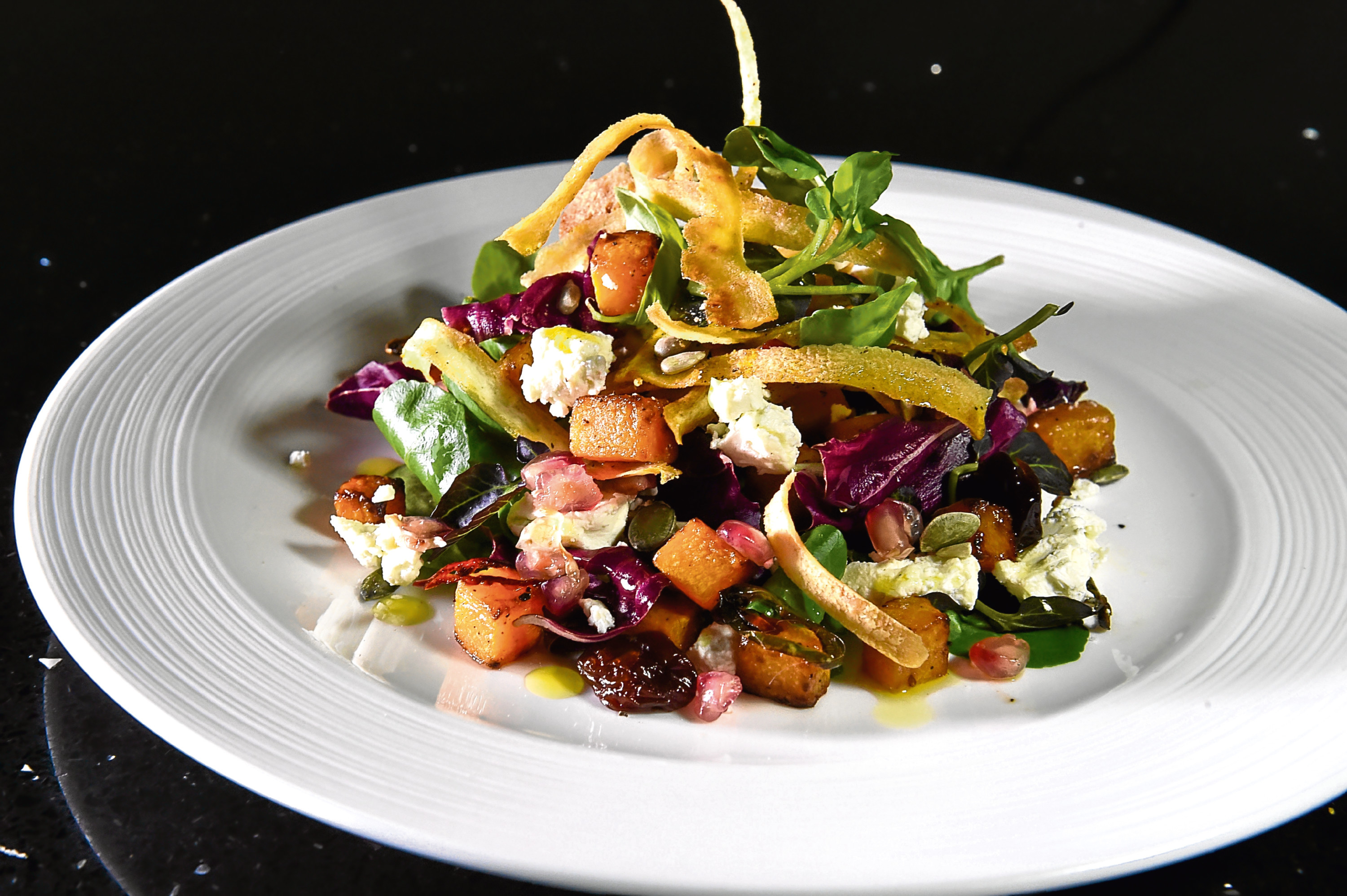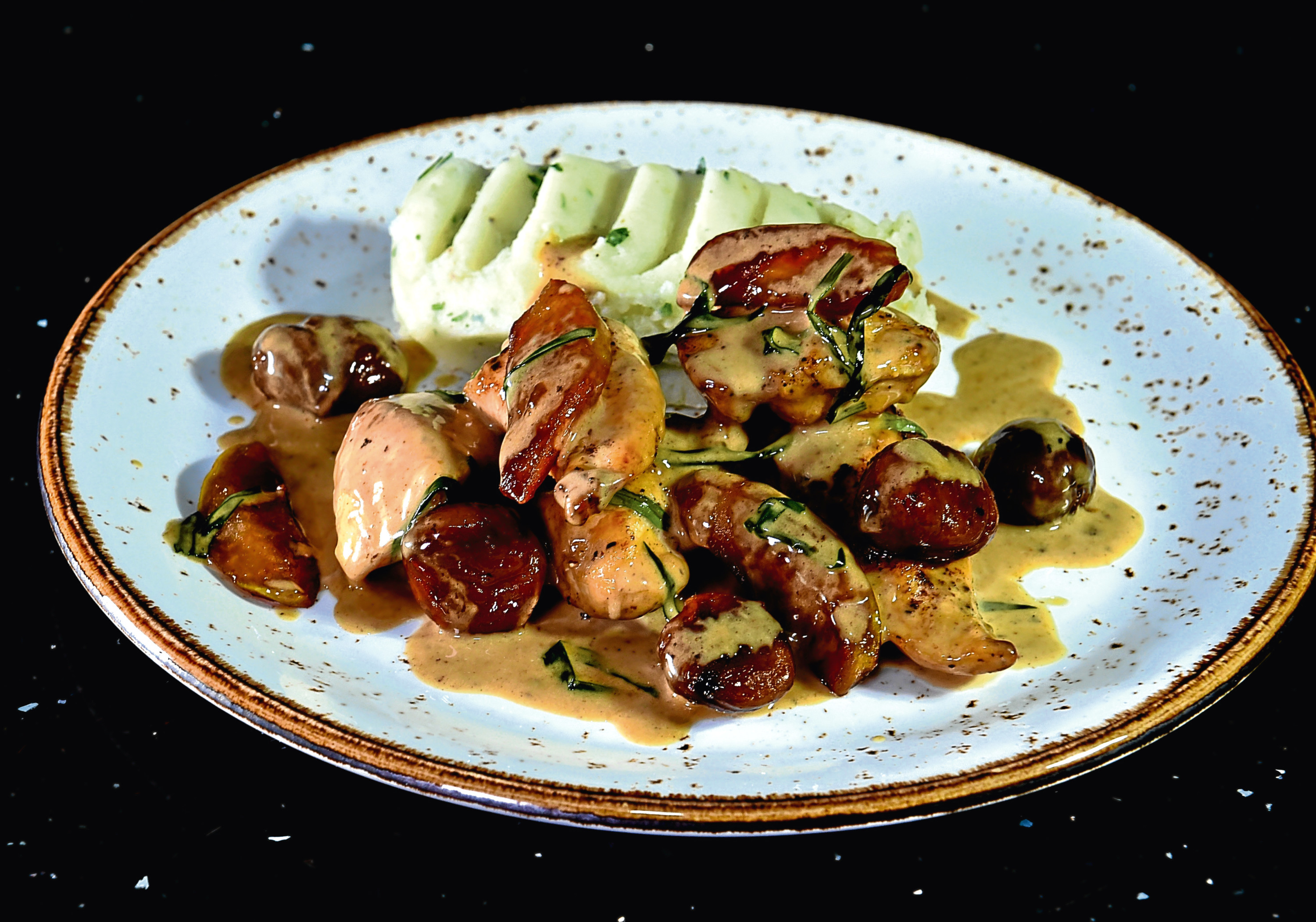My daughter Daisy told me something recently I wasn’t expecting to hear … she’s become a vegetarian.
As a result I’ve been taking a fresh look at some of the dishes we eat as I was keen to make food I knew we would all enjoy. The recipe here, for a winter salad, was created as a result of this.
This is a salad that’s all about texture and flavour. There’s the sweetness of the butternut squash combined with the heat of the chilli, offset by the crumbliness of feta and the crunch of deep-fried slivers of parsnip sprinkled with curry powder. This is a cold dish with a lot of heat and delicious with crisp winter salad leaves such as mini kale and rocket.
I’ve been making today’s second pheasant dish for so long it’s regarded as a classic. It has been re-introduced to the menu at The Kaleyard at Dunblane Hydro and has been flying out the door – folk can’t get enough of it.
For some bizarre reason, people are often a bit scared of cooking pheasant. It’s very low in fat and as long as you don’t overcook it you’ll be fine. Cooked with chestnuts, apples and cider, this recipe is the perfect dish for an autumn dinner party, and best of all, can be done in advance of the guests arriving.
Winter Salad
SERVES 1

The ingredients
- 100g butternut squash
- Half a small chilli
- Half a garlic clove sliced
- 1 sprig of thyme
- Quarter of a pomegranate approximately 25g
- 10g quinoa
- Quarter of a parsnip
- 1tsp curry powder
- 5g mixed seeds
- 50g feta
- 2g sour cherries
FOR THE DRESSING
- 1tsp raspberry vinegar
- 4tsp olive oil
- Half a tsp Dijon mustard
- Salt and pepper
- Mixed leaves
The method
- Dice the squash into 1cm squares and place on to a baking tray with the chopped garlic and chilli. Add the sprig of thyme and a drizzle of olive oil. Roast in a pre-heated oven at 160°C for 10 to 12 minutes until golden and just cooked. Once cooked, remove and keep warm.
- While the squash is in the oven, peel the first layer of the parsnip off and discard. Peel the fresh parsnip into thin slices before deep frying in hot oil (160°C) for two to three minutes or until golden brown. Remove and drain on kitchen paper before dusting with curry powder.
- Cut the pomegranate in half and take the fruit from the shell and reserve for garnishing.
FOR THE DRESSING
- Whisk together the raspberry vinegar, mustard, salt, pepper and olive oil, reserve until needed.
TO SERVE
- Place the salad leaves into a bowl, season and drizzle with the dressing, leaving a little for the end, and arrange onto your serving plate. Warm through the butternut squash if not already warm and arrange it on the plate around the leaves. Sprinkle the seeds, pomegranate and sour cherries.
- Flake up the feta and sprinkle around the leaves, spoon over remaining dressing and serve.
Pheasant, Apples and Chestnuts in a Cider and Tarragon Cream served with Herb Mash and Fine Beans wrapped in Pancetta
SERVES 2

The ingredients
FOR THE CASSEROLE
- 2 pheasant breasts
- 2tbsp vegetable oil
- 30g unsalted butter
- 1 green Granny Smith apple
- 50g pre-cooked chestnuts
- 100ml dry cider
- 100ml brown chicken stock
- 100ml double cream
- Tarragon
- Maldon salt
- Freshly ground black pepper
FOR THE HERB MASH
- 300g mash potato
- 20g unsalted butter
- 30ml double cream
- Flat leaf parsley
- Chives
FINE BEANS AND PANCETTA
- 8-10 fine green beans
- 4 strips of streaky pancetta
- 15g unsalted butter
The method
- Skin and slice the pheasant breast across the grain of the meat (vertically) into thin escalopes to give roughly six pieces per breast. Season with salt and pepper.
- Heat a frying pan over medium heat and add the oil. Add the pheasant pieces one at a time, ensuring they are not on top of each other. Leave them alone in the pan and don’t move them around too much. This will allow them to form a nice crust. Turn the pheasant pieces over and cook for a further two to three minutes as above. Remove the pieces from the pan and allow to rest.
- Add the butter and the sliced apple to the pan, moving them around to ensure they take on a nice colour. Also add in the chopped chestnuts before de-glazing the pan with the cider, using a heat-proof spatula to lift any caramelisation into your sauce. Reduce by half, then add the stock and reduce by half again.
- Add the cream and chopped tarragon then bring to a simmer. Add the pheasant to finish cooking and further reduce the sauce by a quarter or until it has good coating consistency. Check the seasoning and serve.
- For the mash you need to wash, peel and rewash the potatoes, cutting them into thirds. Place into seasoned, cold water and gently simmer until soft enough to mash. Ensure the potatoes are dry before mashing. Add the butter and cream to the potatoes and check the seasoning before adding the fresh, chopped herbs to serve.
- Blanch the beans in seasoned, boiling water for around four to six minutes until tender and refresh straight away in iced-cold water to retain a nice green colour.
- Once cool and dried, wrap the beans in small bunches using the streaky pancetta and fry off in a little butter for a few minutes until the pancetta starts to crisp, then serve.
